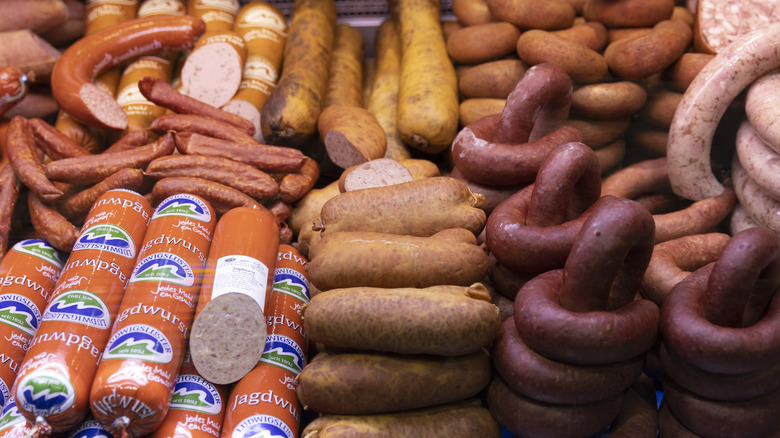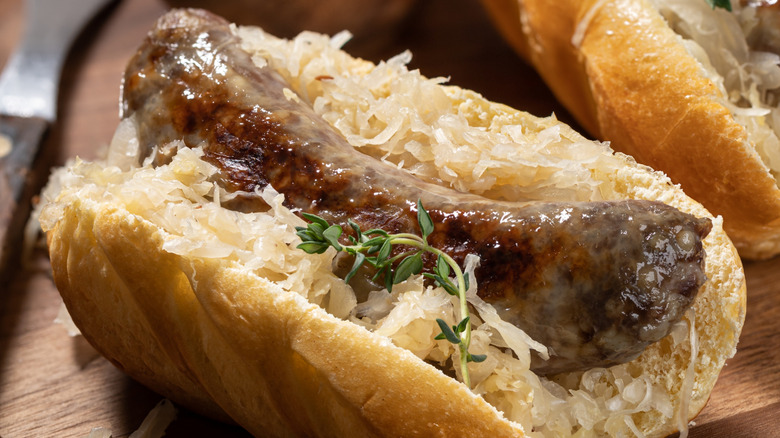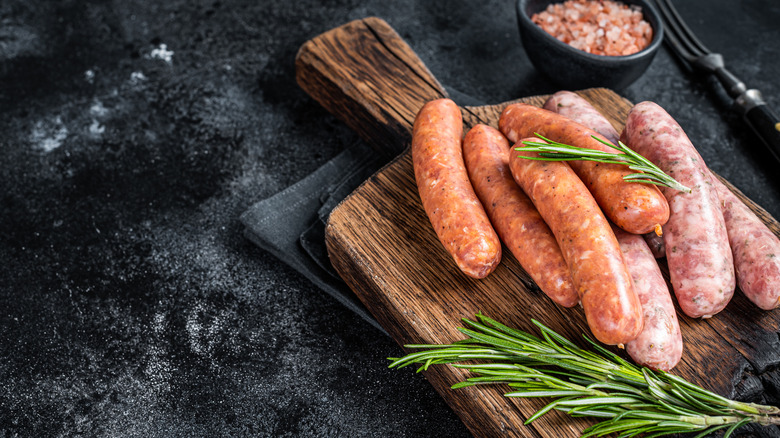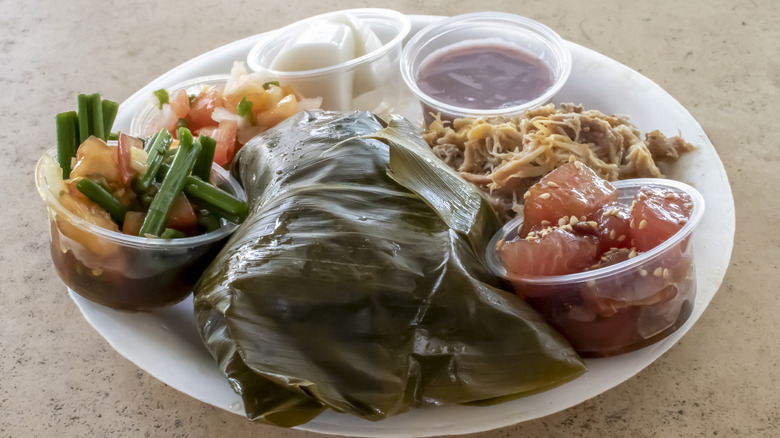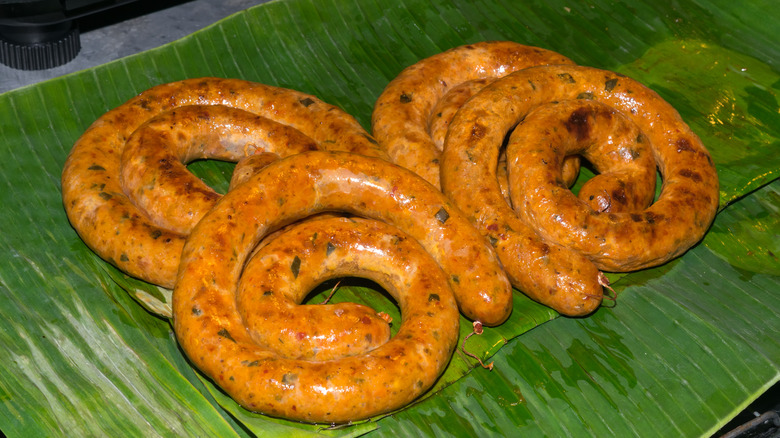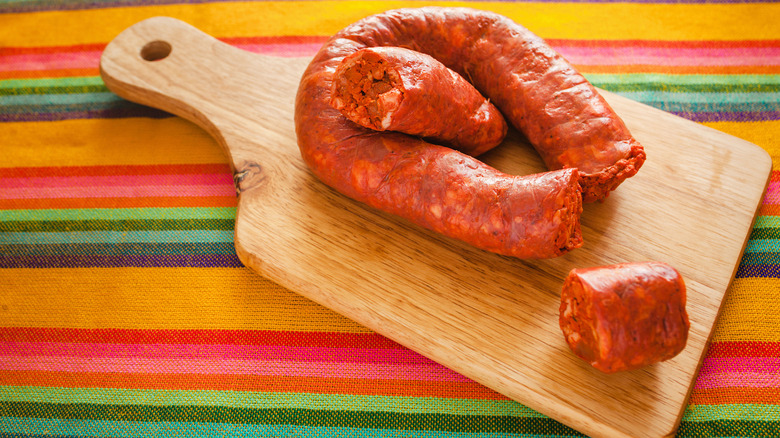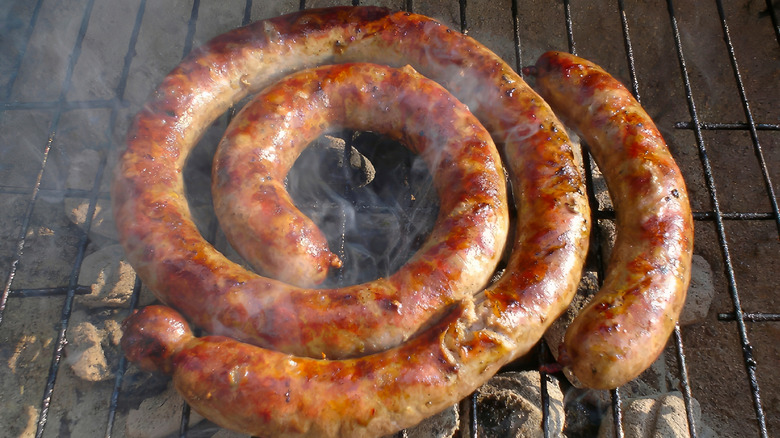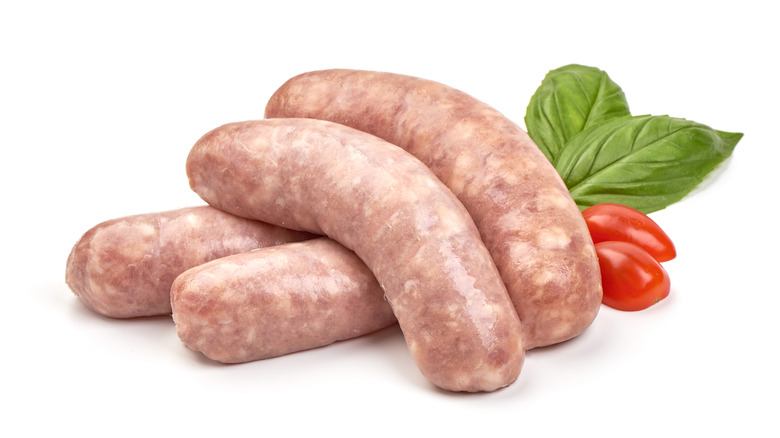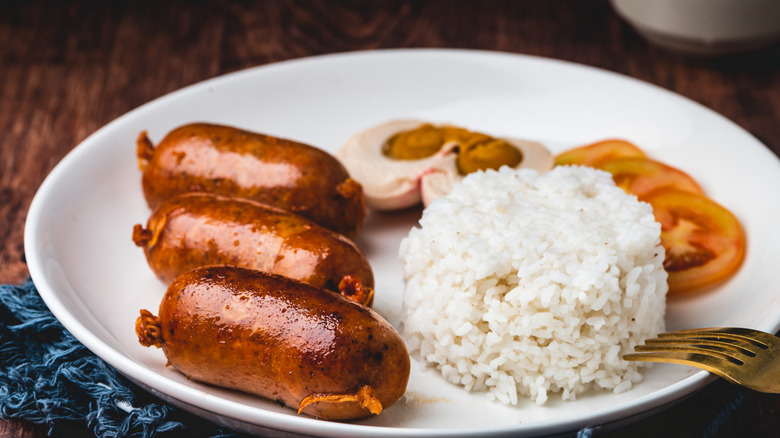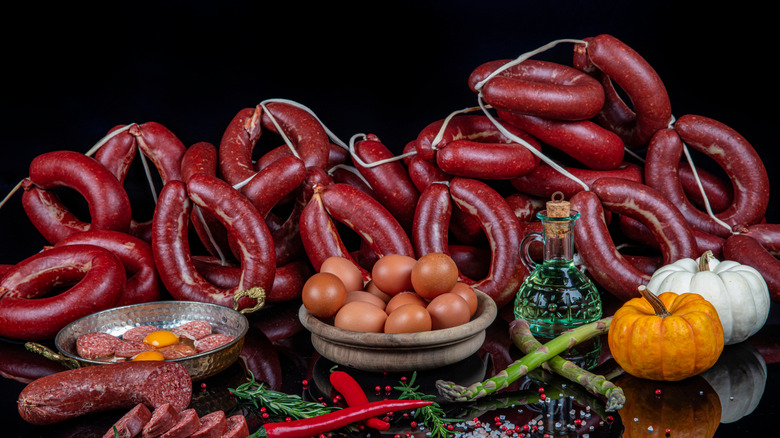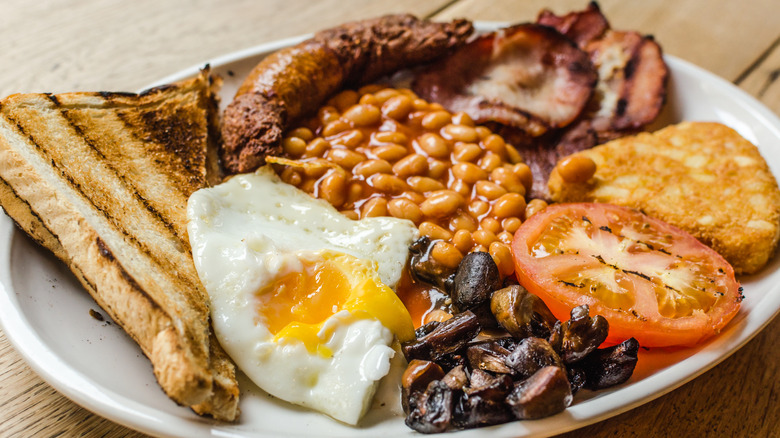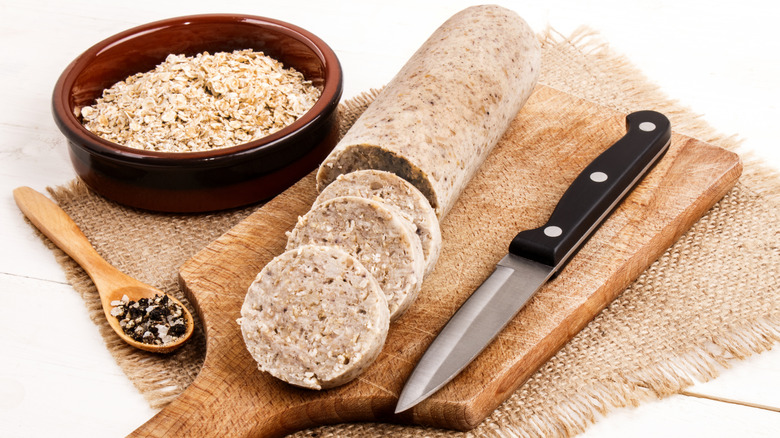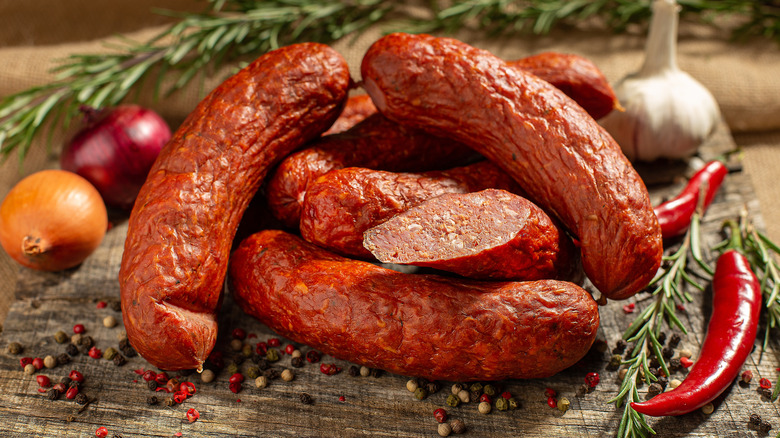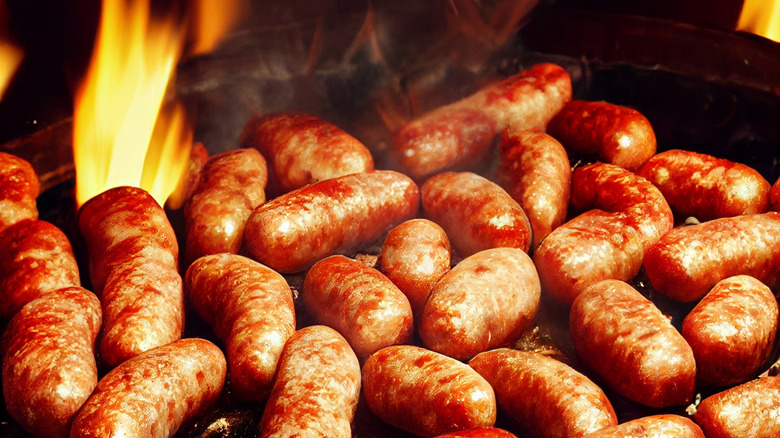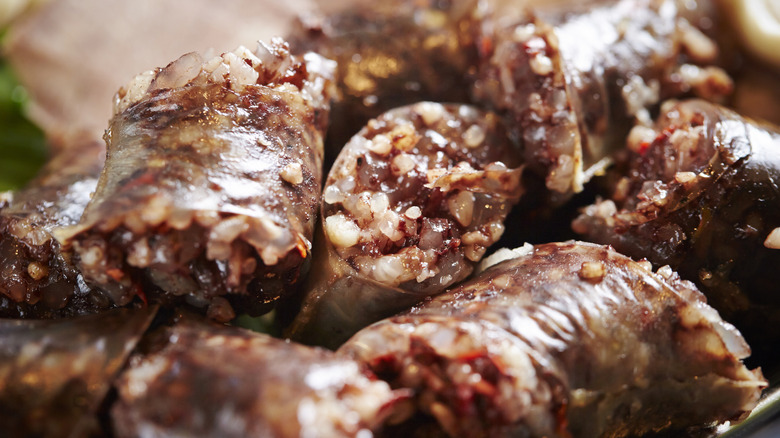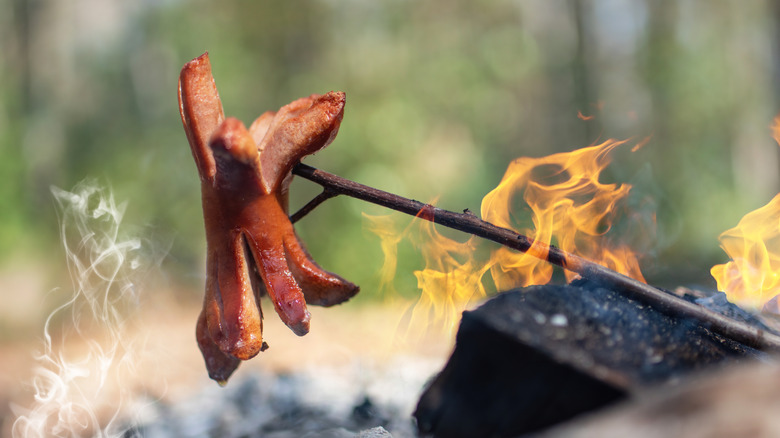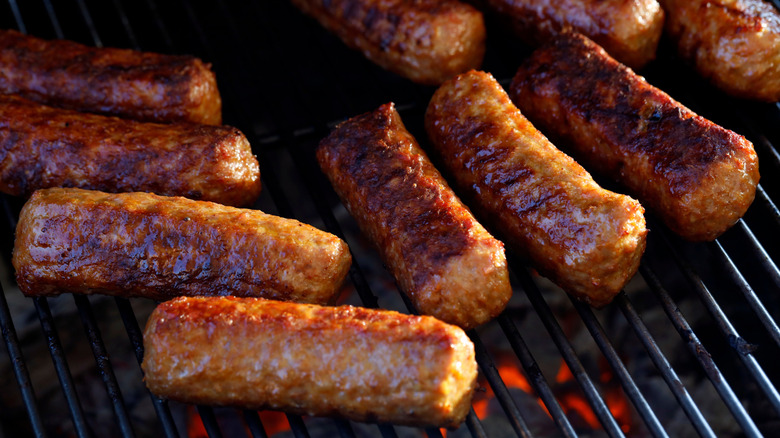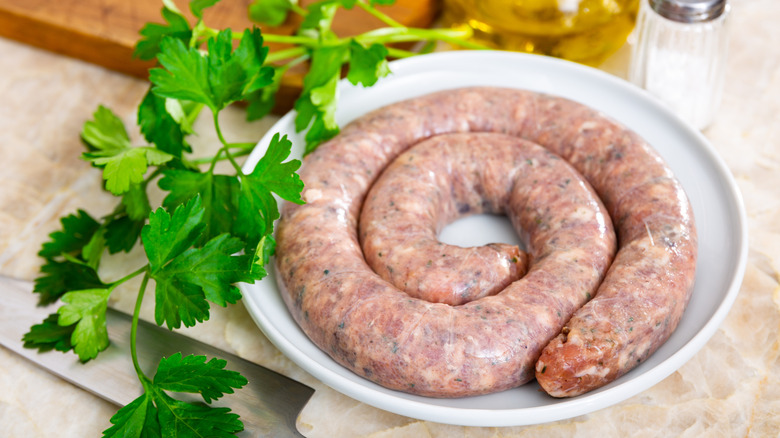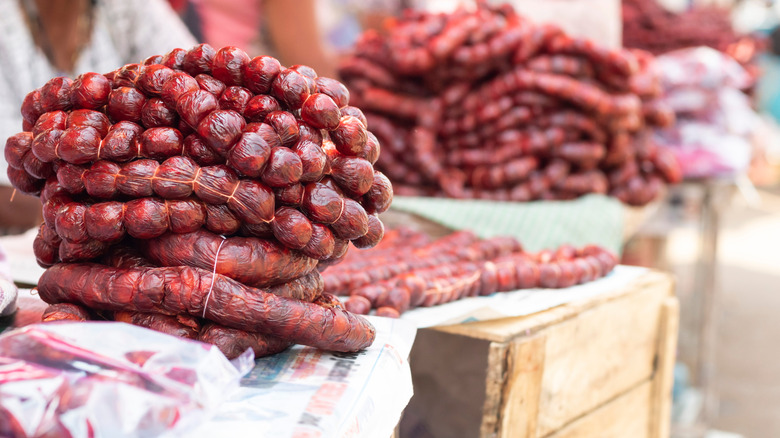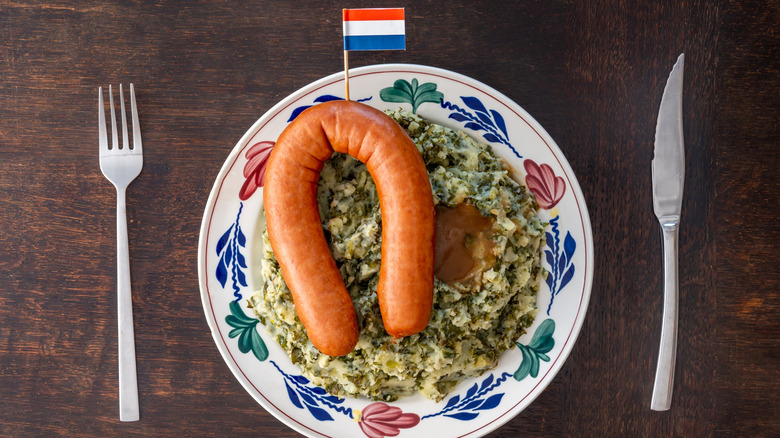26 Of The Most Popular Types Of Sausage From Around The World
Whether you grill it up and eat it on a bun, fry it to add to some of your favorite recipes, or eat it for breakfast — sausage is probably a staple in your diet.
Just browsing through the shelves at the grocery store, you can find several different types of sausage. Some may be made with pork, while others may feature turkey, beef, or another protein as their base. Some types of sausage are even vegan. Beyond the different types of protein used for sausage, the other ingredients and spices can vary widely between different varieties.
You likely already know that there are different types of sausage out there, and you may even realize that many of them originate from other countries. But did you realize that there are actually hundreds of varieties of sausage found around the world? Let's take a look at some of the most popular varieties.
1. Bratwurst - Germany
Bratwurst is arguably one of the most popular types of sausage. It is a German sausage that was created to reduce waste after slaughtering a pig. While pork is the traditional type of meat used for this sausage, other varieties may feature veal or beef. In addition to the protein, one of the other key features of bratwurst is its seasonings. These may include pepper, sage, clove, ginger, and nutmeg. Brats typically have a stronger seasoning profile than some other milder sausages.
This food is made using raw meat, so it must be cooked before consumption. You can cook it however you would like, but two of the most popular methods are grilling and frying. There are many ways to enjoy bratwurst, but the most traditional option would be to eat it on a hard roll. Top the bratwurst with some sauerkraut and spicy mustard. Serve it with a side of potato salad for an authentic German lunch.
2. Chorizo - Spain
Chorizo is another type of sausage that you've probably heard of. There are actually two different Chorizo variations: one from Spain and one from Mexico. They each have their own key characteristics and are used in different ways, so they are typically referred to as two different types of sausage. Let's start by taking a look at the Spanish variation.
Spanish chorizo is made by combining finely ground meat — traditionally pork — with paprika and other seasonings. The sausage is smoky. It could be mild or spicy depending on the specific seasonings used when making it. The preparation process involves curing and smoking the sausages, meaning that they are fully cooked when sold.
When deciding how to enjoy Spanish chorizo, there are a few different options you could consider. The first would be to slice it and add it to soup or stews. You could also add it to other recipes, like paella. Another way the sausage is served in Spain is by pairing it with cheese to enjoy as a snack.
3. Andouille - France
Andouille is a type of French sausage. If you enjoy Cajun dishes like gumbo and jambalaya, you will probably like Andouille sausage. One of the defining characteristics of it is that it's made from a pig's digestive tract. The animal's small intestines and stomach are finely chopped and combined with onions and various seasonings. Once mixed, all of the ingredients are added to the casing (which is made from the large intestine of a pig) before poaching.
Cajun-style Andouille, most commonly found in the United States, is made in a slightly different manner. It combines meat from a pig's upper shoulder with strong seasoning. Once put in the casing, the finished sausage is smoked. In addition to adding Andouille to all of your favorite Cajun recipes, there are several other ways you can enjoy it. Because it is fully cooked, consider adding it to a meat and cheese board for an appetizer. Alternatively, boil or bake Andouille and add it to your favorite rice and pasta recipes.
4. Laulau - Hawaii
Laulau may not match your vision of a traditional sausage. Rather than being placed inside a casing, this popular Hawaiian food is wrapped in taro plant leaves, called lūʻau leaves.
It is most commonly made using pork. But other proteins, such as fish, chicken, or beef, can also be used. The other key component of laulau is salted butterfish. The salted butterfish (also known as black cod) is added as a second layer in the wrap around the protein.
Years ago, laulau was cooked in an imu. This underground oven used hot rocks to cook foods. Today, it is most often steamed on the stovetop. Laulau is considered a Hawaiian comfort food by many. If you ever go to Hawaii and order a plate lunch, you'll notice that many feature laulau. With these plate lunches, you're likely to see the laulau served alongside rice and macaroni salad.
5. Sai Ua - Thailand
While sai ua originated in the northern regions of Thailand, the sausage has gained a lot of popularity, and can now be found across the country. Sai ua translates to stuffed intestine, the basic definition of what this sausage is.
Sai ua has a very aromatic flavor, which is imparted by the regional ingredients used to make it. In addition to the pork protein, sai ua recipes often call for red curry paste, lemongrass, turmeric, galangal, and makrut lime leaves. While these ingredients may be hard to come by — especially fresh — in many parts of the world, they are much more common in Thailand.
Sai ua is made using minced pork, giving the sausage a coarser texture than many other types. Grilling is one of the most common ways to enjoy eating it. In Thailand, it is often paired with sticky rice and eaten as an appetizer.
6. Chorizo - Mexico
While Spanish chorizo is smoked — making it fully cooked — Mexican chorizo is sold raw. It needs to be cooked before consumption. However, this isn't the only difference between the two variations.
While Spanish chorizo is traditionally made with pork, Mexican chorizo could also be made with beef. Mexican chorizo is also spicier than its Spanish counterpart. In addition to the protein used for this sausage, it is also made using red peppers and various other seasonings, such as clove and cinnamon.
There are many different ways to enjoy Mexican chorizo. Because of how it is seasoned during the preparation process, you won't need to do much to enhance its flavor. You can add Mexican chorizo to tacos, burritos, nachos, or any of your favorite Mexican recipes. You could also grill it up to add to omelets, put it as a topping on a hamburger, or use it any other way you'd like.
7. Boerewors - South Africa
South African boerewors sausage must be made using beef. However, other types of protein, including lamb or pork may be added to the recipe. The coil-shaped sausage is also required to have a meat content of at least 90%. Moreover, the meat used to make it may not have a total fat content greater than 30%. Vinegar and various other ingredients and spices — like black pepper, coriander, allspice, and nutmeg — make up the last 10% of the recipe.
Beyond its distinct flavor, boerewors also has a more unique texture, compared to many other popular sausage types. The meat used to make it is not as finely ground, meaning its texture is not as smooth as you may be used to.
Boerewors is a popular dish served at South African barbecues, called braais. The large coil is grilled up and guests are served slices to pair with the other sides and entrée options. Some of the foods commonly served alongside boerewors include meat kebabs called sosatsies. Grilled cheese, onion, and tomato sandwiches called braaibroodjies are another option. You may also see people enjoying their boerewors on a bun.
8. Salsiccia - Italy
Salsiccia is a term that refers to fresh Italian sausages. Most are made using ground or finely minced pork. The ground pork meat is often combined with pancetta scraps or pieces of pork neck.
The seasonings and other ingredients added to salsiccia vary in different regions of Italy. In the southern regions of the country, garlic, fennel, sun-dried tomatoes, and chili peppers are commonly added. Bits of cheese — specifically caciocavallo cheese — are also added to the recipe. The flavor of the salsiccia sausage will be different in northern regions of the country. There, it is traditionally prepared with white wine, garlic, cinnamon, and pepper.
Grilling the sausage is one of the top ways to eat it. When grilling — or cooking using another method — chefs poke small holes about an inch apart into the sausage using a needle or toothpick. These tiny holes ensure that some of the fat will drain as the sausage cooks. You can add salsiccia sausage to stews, pasta dishes, sandwiches, pizzas, and more.
9. Longganisa - Philippines
Longganisa is a type of Filipino sausage. The name longganisa sounds similar to longaniza, an Argentinian sausage. The reason both of these countries have sausage with similar names can be attributed to Spain colonizing both areas.
In the Philippines, the term longganisa is used when talking about any type of sausage that is made using spices found in the country. While there are several different types of longganisa in the Philippines, most feature either pork, chicken, or beef as the protein. Similarly, Prague powder is a common ingredient across many of the different varieties. Longganisa is most commonly sold fresh, meaning it must be cooked before consumption.
This type of sausage is a popular addition to many breakfast dishes. However, it is also viewed as an excellent addition to a lunch or dinner. In many cases, you'll find longganisa served with pickled vegetables or vinegar. Because there are so many different variations of longganisa throughout the Philippines — and each has its own unique flavor — the ways it can be enjoyed can also vary widely. There are two main types of Longganisa that you may see: savory and salty longganisa (referred to as "de recado") and sweeter longganisa (referred to as "hamonado").
10. Breakfast sausage - America
While it is such a staple now, breakfast sausage hasn't always been around. However, it does have a long history in this country. About 300 years ago, in the 1800s, farmers came up with the idea of making breakfast sausage to help create a more filling meal to enjoy at the beginning of the day. The farmers didn't want to waste parts of the animals that they slaughtered, so they used them to make sausage. Not only was breakfast sausage satisfying and a good way to reduce waste, but it was also more affordable, which helped it gain popularity.
You can find breakfast sausage everywhere now, from the grocery shelves to nearly any restaurant's breakfast menu. It may be sold in link or patty form. Breakfast sausage is traditionally made with pork, though you can find several other variations today. The pork (or other protein) is ground before being mixed with some seasonings. While various seasonings are added to breakfast sausage, it has a much more mild taste than other types of sausage more commonly consumed for lunch or dinner. Browning on a skillet is the traditional way to prepare it.
11. Sucuk - Turkey
Sucuk is a type of spicy sausage from Turkey. Also spelled soudjouk or sujuk, this type of sausage is made using beef and occasionally some lamb. In addition to being popular in Turkey, there are similar variations that you may find in the Middle East, Eastern European countries, or the Balkans.
When sucuk is made, ground beef is combined with seasonings such as sumac, garlic, cayenne pepper, and cumin. After the beef and seasoning mixture is added to the casings, it is cured or dried.
Sucuk has a unique flavor. It is also a fattier sausage than several other varieties. Its higher fat content and seasoning profile allow it to enhance the taste of many different dishes. It may be added to stews, namely kuru fasulye, a tomato and navy bean stew popular in Turkey. Sucuk is also served with breakfast in egg dishes or on a platter with bread, olives, and fruit.
12. Black Pudding - United Kingdom
If you've ever eaten a traditional English or Irish breakfast, you may have already tasted black pudding. But, do you know exactly what it is that you ate?
Black pudding has a key distinction from other types of sausages: it is made using blood. The blood is mixed with oatmeal and cooked until it becomes thicker. As it cools, the mixture will congeal, giving it its classic texture.
Compared to other types of sausage, black pudding is a healthier selection. It is high in protein, while low in carbs and calories. In addition to being served alongside a traditional Irish or English breakfast (where slices of it are typically fried), black pudding can also be added to other dishes. For example, you can crumble it and add it to your gravy for added flavor, or add it to mashed potatoes for a spin on the classic recipe.
13. White Pudding - Ireland
Now that you know what black pudding is, what about white pudding? Despite their similar names, white pudding and black pudding are not the same. While black pudding is made using blood, no blood is added to white pudding. Rather, the traditional recipe — which originates from Ireland — includes pork meat or pork liver, along with oatmeal, bread, and suet (animal fat). With Irish white pudding, potato flour and spices may also be added to enhance the flavor of the sausage.
White pudding is another classic component of a traditional Irish breakfast. Some of the other parts of an Irish breakfast include eggs, bacon, baked beans, potatoes, mushrooms, and toast. When served alongside breakfast entrées, the sausage is commonly cut into slices before frying or grilling it. Despite the name, a traditional Irish breakfast may be eaten at other times of the day, such as for lunch. The flavor of white pudding is much lighter and more subtle than that of black pudding.
14. Wiejska - Poland
Wiejska kielbasa from Poland is one of the most popular sausage types in the European country. Traditionally made using both ground pork and ground veal, wiejska has a delicious flavor. In addition to the ground pork and veal, recipes call for seasonings, namely marjoram and garlic. Wiejska translates to a rural, or country area in Polish. The sausage was likely first developed away from the busier cities.
The sausage is smoked, meaning it is safe to consume without cooking. You can even thinly slice it to make a sandwich. You could even simply leave the wiejska whole and place it on a bun with some sauerkraut and mustard. The kielbasa can be cooked in many ways, allowing you to create many flavorful meals. Consider grilling, frying, or baking wiejska before adding it to your favorite stew, casserole, or pasta dish. You'll notice its amazing flavor with the first bite.
15. Käsekrainer - Austria
If you ever take a trip to Austria, you may have the opportunity to order Käsekrainer sausage. This sausage variety is plump and contains several bits of cheese throughout (Käse means cheese in German) which is why this sausage was given its name. The inclusion of cheese inside the casing does more than offer a unique and flavorful taste to the sausage — but it can actually make it almost hazardous to cut into. If you don't take extra care when cutting it, the molten cheese on a freshly cooked sausage may come spewing out when a knife punctures the casing.
Käsekrainer tastes incredible when paired with a roll, mustard, and ketchup — this is how it is most typically served at sausage stands throughout Vienna and other parts of Austria. But there are no rules saying you couldn't grill it up to include in a favorite pasta or rice dish. However you eat it, the gooey cheese is going to help it taste amazing.
16. Kupati - Georgia
Do you enjoy spicy sausage? If so, you might want to try kupati. This Georgian sausage gets its spice from the coriander, black pepper, and garlic that are added to the recipe. Some of the other key ingredients include cinnamon and onions, but you can also find variations that incorporate parsley, mushrooms, cheese, or potatoes. Traditional kupati recipes feature either pork or beef. When the sausage is prepared, the casings are shaped into horseshoes.
In the Caucasus region, where many people enjoy Kupati, you'll often find it served with sauerkraut. Pomegranate seeds and coriander may also top the sausage, serving as a garnish. While you could choose to boil or bake kupati, grilling or frying are the ways you're more likely to see it prepared. Keep in mind that kupati is a raw sausage. This means that you will need to cook it before eating it. It cannot simply be sliced and eaten as you can do with some other types of sausage.
17. Sundae Sausage - South Korea
Sundae sausage, also spelled soondae, comes from South Korea. It is a type of blood sausage made with pig's blood, glass noodles, and rice. Other ingredients — such as fish, squid, bean sprouts, soybean paste, scallion, barley, or kimchi — can also be found in some regional variations. Because of its ingredients, the texture of Sundae sausage is different from what you'd traditionally think of with sausage. While it is quite dense with all of the different ingredients stuffed together, the noodles and rice give it more of a gelatinous texture.
The original variety of the sausage is believed to have first been developed between 918 and 1392 during the Goryeo period. There are many different ways you can eat Sundae sausage. One option is to brown it, slice it, and pair it with apples or potatoes to help balance out its higher iron content. Sundae sausage is also a key ingredient in various Korean dishes such as stir-fry (sundae bokkeum) or soup (sundaeguk).
18. Cervelat - Switzerland
The pride of Swiss cuisine, cervelat is widely recognized as the quintessential sausage of the country. Although this is slightly debatable, many claim that the first cervelat recipes included brains; the modern version is made with a combination of pork and beef, along with some bacon, pork rind, and a few simple spices for added flavor. The meat mixture is then stuffed into casings made with Brazilian zebu cow intestines.
One of the reasons cervelat has always been highly appreciated is its convenience, as it is pre-cooked and can be eaten as is. However, it can also be boiled, seared, or grilled to further elevate its texture. Though most Swiss people enjoy cervelat by slicing it open at both sides and then grilling it over a wood-packed fire pit, it is also used to make some classic regional recipes. One of them is Arbeiter-Cordon-Bleu –- a dish where the sausage is slit from the center, packed with cheese, mustard, and pickles, then wrapped in bacon and baked.
If you don't eat meat but would still like to try the sausage, there's good news for you. Vegetarian and vegan variations of cervelat made with ingredients like tofu and beans have also become a staple in Switzerland.
19. Ćevapi - The Balkans
Ćevapi is a beloved sausage from the Balkans celebrated for its perfectly crispy sear with a juicy center. Since it is widely enjoyed across Serbia, Croatia, Slovenia, Bosnia, Herzegovina, and even Bulgaria, it's difficult to pinpoint which country this sausage hails from. However, many link ćevapi's origins back to the time when the Ottoman empire ruled over the Balkan region.
Though ćevapi has numerous versions from all these countries (no surprise there!), the most popular way to make it remains with beef and pork meat — particularly the fatty kind. Sometimes, onion or garlic are added to the recipe to boost the flavor, but seasonings like salt, pepper, and paprika remain staples in ćevapi across most regions. Some people even use baking soda in their recipe to make the meat extra succulent.
Besides its flavor and varieties, what makes ćevapi unique is that it isn't packed in any casing despite technically being a sausage. After the meat is minced and mixed with spices it is directly rolled into sausages and grilled. This is also why it is often believed that ćevapi is very similar to Turkish kofte, pointing back to its Ottoman roots. The sausage is delicious enough to be enjoyed on its own. But, in most Balkan countries it is commonly eaten with a type of regional flatbread, a rich spread made with clotted cream called kajmak, a roasted red pepper sauce, and some raw onions.
20. Barbecue Snags - Australia
Outdoor living and meet-ups are a big part of Australian culture, so it isn't a shocker that sausage grilling sessions in their backyards are almost a tradition. As for the name, "snag" is just an Australian term for a sausage, which makes sense as people from down under do have unique names for certain food items, including Rice Krispies cereal! Since these snags are cooked over a barbecue, they are aptly named.
These beloved Australian sausages are a bit similar to the ones sold in the US as most types are made with pork or beef. But, you can also find varieties made with non-traditional meats like emu or even kangaroo. It's also worth noting that most of these sausages aren't pre-cooked.
Barbecue snags are grilled until they have a smoky finish with a tender and juicy interior. While grilled snags can be eaten as they are, they're great paired with sauces like ketchup and mustard. A popular way to enjoy the sausage is by placing it in a slice of bread and topping it with simple condiments, which is also called a sausage sanga in certain regions of Australia.
21. Cumberland Sausages - England
If blood sausages seem too much for your palate but you'd still like to give a classic British sausage a go, this one's for you. Cumberland sausages are a regional delicacy from the county of Cumberland located in Northwestern England. They are traditionally made with fatty cuts of pork that are lightly seasoned with salt and pepper and may contain other basic spices, too, like nutmeg and cayenne pepper. Additionally, Cumberland sausages have certain distinctive characteristics that are worth knowing.
Firstly, they are unlinked sausages that are usually sold in large ring-shaped coils. Besides that, rather than minced meat, they are made with chopped meat which gives them a pleasantly hearty bite. They are also never pre-cooked and hence need to be boiled, seared, or grilled before they can be consumed.
Many folks enjoy eating Cumberland sausages without any accompaniments, considering their rich and fatty flavor. They are often also used to make certain renowned British recipes like bangers and mash, sausage rolls, and toad in the hole. Cumberland sausages can easily replace blood sausage in a full-English breakfast spread as well, and for a truly traditional meal you can pair them with Cumberland sauce to elevate their flavor.
22. Choris - India
Although India might not come to mind when thinking of sausages, the country does offer one particular kind that meat eaters (at least those who eat pork) can't get enough of: Choris, a type of sausage from Goa in Southwest India. The state had Portuguese settlers for centuries, which led to the locals taking inspiration from their chouriço. While there are similarities between choris and chouriço –- like using pork meat and casings made with pork intestines — the Goan version also has some distinctive features. What mainly sets the two apart is that choris is, of course, made with local ingredients.
The sausage reflects Goa's food culture as it is heavily spiced with red chilis, and also contains toddy vinegar (made from coconut sap, which is abundant in the state). After the spicy meat is stuffed into casings, choris is smoked and then sold in local markets across Goa. Often smoked over coconut husks, this process also gives the sausages a flavor that is unique to the state.
Every part of Goa has its own recipe for choris. Some of these include cashew feni as an ingredient, which is a local alcoholic beverage that adds a zesty flavor to the sausage. Choris needs to be boiled or seared before eating. Some common ways to enjoy it are with pav –- a type of soft bread — or adding it to rice dishes like pulav.
23. Liverwurst - Germany
Germany is well-known for its sausages, so liverwurst definitely deserves a spot on this list. Although liver is the primary ingredient, the rest of it can be other types of offal, or even meat. The sausage particularly contains at least 30% pork, sheep, veal, beef, or goat livers. The recipe for liverwurst differs from one part of Germany to another.
Besides the offal and meat, the sausage is also packed with various seasonings and spices, like salt, pepper, and coriander to name a few. These additions make it palatable even for people who aren't the biggest fans of liver.
Liverwurst is pre-cooked so it can be eaten as it is, with one of the most popular ways being spreading it on slices of bread thanks to its pâté-like consistency. That said, some folks also enjoy grilling or frying their liverwurst and then serving it alongside eggs for breakfast.
24. Rookworst - Netherlands
Once made to extend the shelf life of meat, rookworst is a sausage that's now a cherished delicacy in the Netherlands. It's usually made with minced pork, though these days there are also versions of the sausage made with beef and veal, along with vegetarian options. The meat is seasoned with spices like pepper, nutmeg, and salt, and it is also available in both raw and cooked forms. Folks from the Netherlands mostly devour cooked rookworst with mustard or have it with stamppot, a beloved Dutch recipe consisting of mashed potatoes and vegetables.
Rookworst is packed in natural casings and then smoked, giving it a lovely crispy texture along with a uniquely deep smoky flavor. No wonder the word "rookworst" literally translates to smoked sausage!
Additionally, it's easy to identify rookworst as it has a signature horseshoe shape. This was originally done because tying the ends made it easier to hang and smoke it back in the day, and the sausage is still sold in the same traditional shape today.
25. Kazy - Central Asia
Though it is often overlooked, Central Asian cuisine offers fantastic delicacies like the remarkable sausage, kazy, which is a major part of the food culture in countries like Kazakhstan, Uzbekistan, and Kyrgyzstan. Horses have long been valued in Central Asian culture both for transportion and food. This is exactly what sets kazy apart from other types of sausages, as it is made with horse rib meat.
The meat in this sausage is left whole rather than being chopped or ground and then stuffed into horse intestines, giving it a wholesome bite. It is also lightly seasoned with salt and simple spices like pepper and garlic. Kazy is available in both raw and fully cooked forms, with the cooked version, in most cases, being boiled and then sold in local markets.
Kazy is a major part of celebrations in Central Asia and in Uzbekistan and Kyrgyzstan it is added to recipes like plov (a rice dish with meat) and norin (a noodle dish with sliced sausage or meat). In Kazakhstan, the sausage is enjoyed with local bread and is also served with traditional dishes like beshbarmak –- a noodle dish with meat. In addition, if you ever travel to these Central Asian countries, you will also come across smoked or dried versions of kazy in the food markets.
26. Merguez - North Africa
A North African specialty, merguez is a sausage widely popular in Libya, Algeria, Tunisia, and Morocco. It is typically made with lamb meat and fat. Unlike many other sausages, it is never made with pork due to a predominantly Muslim population in the region; however, you may also find versions made with beef and veal. Merguez can easily be recognized by its striking crimson color, which comes from the addition of harissa, an African chili paste. This paste also makes the sausage extra spicy. Merguez recipes vary from one region to another, with some including added spices and even rose petals.
Besides the flavor, this sausage is special because it is available in two forms: you can find the meat stuffed into casings, as well as simply rolled into a sausage shape and then grilled — the latter being the more popular method. Merguez is commonly eaten with couscous and added to classic North African egg dishes, but due to its rich flavor, people also love eating it by itself.
You might be surprised to know that merguez is an equally important part of the food culture in France. After colonizing parts of North Africa, the French loved the sausage so much that they took it back with them, leading to it becoming a staple in the country.
